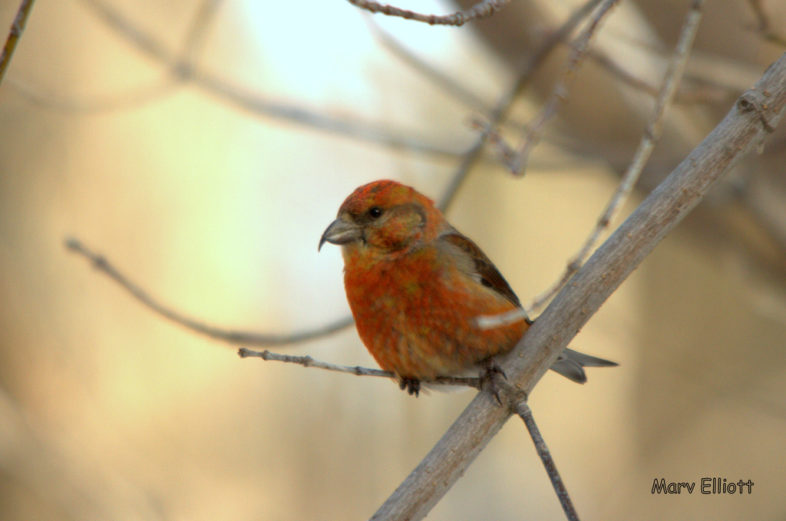Its finally happening. Red Crossbills are arriving. This year’s bumper cone crop of pine, spruce, larch, and hemlock is perhaps a once in couple-decades event. As a result, crossbills were predicted to flood into the region and birders have been waiting with anticipation.
Red Crossbills (Loxia curvirostra) remain an enigma and birders like you can help solve some of the mysteries. Red Crossbills come in many shapes and sizes that appear to match their main food sources. There’s one called the Appalachian Red Crossbill and it has a medium-sized bill. There’s another called the Newfoundland Red Crossbill which has a large beak and mostly feeds on Black Spruce. The Cassia Crossbill (Loxia sinesciurus) was just another one of these red crossbill populations, found only in the South Hills of Idaho, until just this year when there was enough evidence to elevate it as its own species. Many scientists now recognize many ‘types’ of Red Crossbills. Understanding how these different types wander about the continent, or not, is a puzzle that will require an army of observers – birders like you – armed with recording devices and eBird.
Ornithologists have discovered that each Red Crossbill population gives a distinct flight call. The flight calls are the sound typically described as jip-jip-jip and usually heard when the birds are flying overhead, but sometimes even when they are perched. As many as 10 ‘call types’ of Red Crossbill can be found across North America. These call types have been found to correspond to slight differences in size, genetics, and core habitats.
Identifying a call type by ear is a challenge, but with experience, some differences can be learned. But to be sure of the identity of the call type, ornithologists use audiospectrographic analysis. Raven Lite software can be used to do this analysis. The software produces an image of the flight call. Since each type of flight call has a specific shape and frequency, scientists can match them for an identity, or type. In addition to flight calls, Red Crossbills also give other calls and various songs. Excitement calls, known as “toop” calls, can aid in identification to call type too. Songs aren’t much help for typing, at least not yet.
Discovering Vermont Red Crossbills
There’s been remarkably little work done here in Vermont with Red Crossbills. But this week, I found a rare type. Kyle Jones found Red Crossbills in Marsh-Billings-Rockefeller National Historical Park during the Woodstock Christmas Bird Count. With my recording equipment in hand, I went after them. After a few hours I managed to capture just a few minutes of calls from a small flock in the distance. But it was enough. Within hours of uploading it to my Vermont eBird checklist, one of the experts was in touch. I had found a type 4 Red Crossbill – the Douglas-fir Crossbill. With its core range in the Pacific Northwest, this bird was well out of range. It represents perhaps just the 6th record in the Northeast and one of the farthest east. There are likely a lot more of them to be found. Type 4 have moved eastward this year, and many records have already come in from the Great Lakes. First state records have already been established this year in several states.
Types known from Vermont:
- Type 1 – Appalachian Crossbill. One record in Vermont eBird. (2012)
- Type 2 – Ponderosa Pine Crossbill. One record in Vermont eBird. (2015)
- Type 3 – Western Hemlock Crossbill. One record in Vermont eBird (2017)
- Type 4 — Douglas-fir Crossbill. One record in Vermont eBird (2017)
- Type 10 – Sitka Spruce Crossbill. Four records in Vermont eBird. (2012, 2015, 2017)
HOW TO HELP DOCUMENT RED CROSSBILL TYPES
Anyone with a recording device – from smartphone to professional-grade equipment – can capture recordings to determine the call type. It is always better to download a sound recording app that makes .WAV files, which prevent loss of important audio information. However, even using the “voice memo” feature can get a decent recording that can help to type the crossbill. For example, on an iPhone just open your audio recording app, hit record, hold your phone as steadily as possible with the speaker toward the sound. External microphones can be purchased that improve the recording quality even more; check out recommendations from the Macaulay Library. Even poor recordings can often be typed, so be sure to upload them even if you think they might low-quality.
Matt Young, one of the North America’s experts on this complicated species complex, and Tim Spahr, an expert on typing crossbills, are reviewing all recordings submitted to eBird.
If you record a Red Crossbill, please enter it as “Red Crossbill” in Vermont eBird, upload the recording to your checklist. If identification to Type is confirmed from the recording, you can easily use the new “Change Species” feature to search for the correct crossbill type and revise the identification. If you try to identify the type yourself, do not worry if you misidentify the proper call type; one of the experts will contact you after listening to your recording.
Learn more
- Read an in-depth article by Matt Young and Tim Spahr with information about each call type.
- All About Birds Guide – Red Crossbill
- Explore Audio and Visual files shared to Vermont eBird.


Cool article. I guess I need to see if I have them here.
Record them with your camera on video and I can pull the sound off and put them up on eBird so we can Type them.
I need to find one first. I have never seen one here. I looked at there range and I should have them. New treasure for me to find.